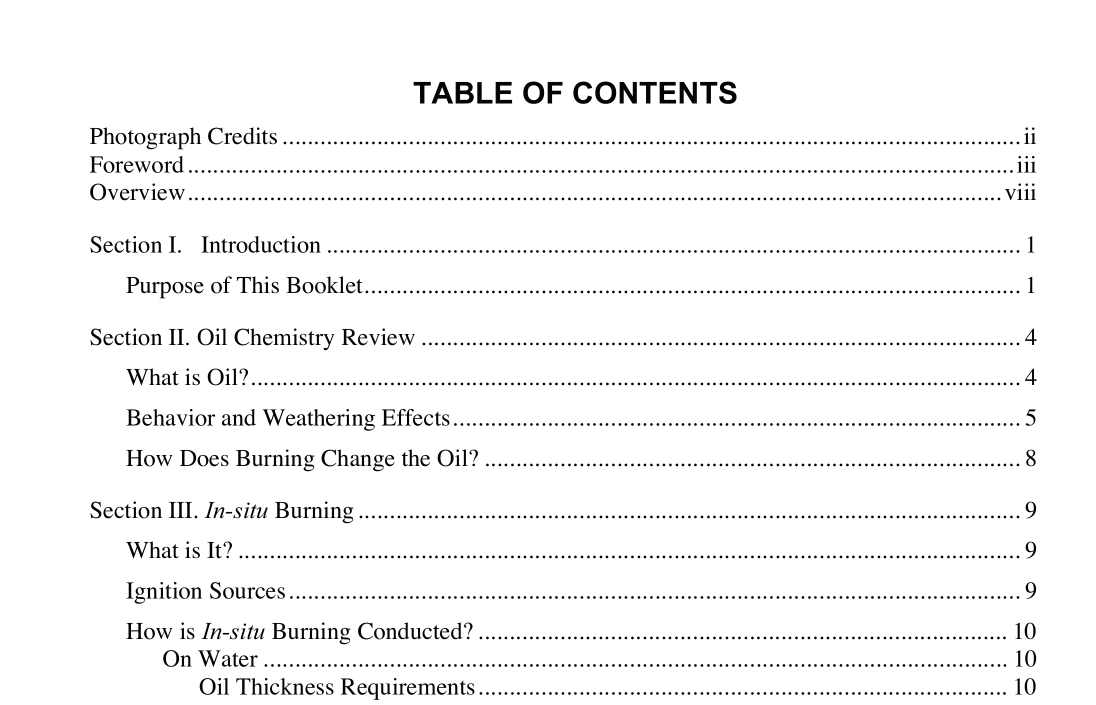API Publ 4740 pdf download

API Publ 4740 pdf download.A Decsion-maker’s Guide to In- situ Burning
Burning the oil in-situ allows for the rapid removal of liquid oil, that has been collected and contained, from the ground and water surface. An ISB converts the liquid oil into its primary gaseous combustion products- water and carbon dioxide, plus a smaller percentage of other unburned or residual by products, including soot and gases (NRT, 1992). ISB does not completely remove spilled oil from the environment; the burned oil is primarily converted to airborne residues (gases and large quantities of black smoke or soot) and burn residue (incomplete combustion by- products) (see Figure 3). The airborne residues have the potential to negatively impact natural resources by introducing toxic . components through inhalation or direct contact with the various combustion by-products. For more information, refer to Section VI within this volume. During an ISB, the effect of the combustion plume on downwind human populations and natural resources is a significant concern. One of the key issues associated with ISB effects is the presence of PARTICULATE MATTER, and particularly the small particles less than 10 microns in diameter that are referred to as“PM- 10.” The particulate matter in the smoke is composed primarily of elemental carbon. Particles smaller than 10 microns are easily inhaled and drawn deeply into the lungs where they can lodge and cause damage. Carbon dioxide is the primary gaseous by-product from an ISB. Additional gaseous by-products include carbon monoxide, nitrogen oxides, sulfur oxides, and volatile organic compounds. Human exposures (acute and chronic) to each of these gases (CO, NO、 SO2, and VOCs) are regulated by the USEPA’ s National Ambient Air Quality Standards (NAAQS) and the Occupational Safety and Health Administration (OSHA). OSHA requires that the levels of exposure must be monitored when humans can be exposed to these chemicals via inhalation or direct dermal contact (like during an in- situ burn).
In-situ means“in place.” In-situ burning refers to the controlled burning of oil spilled from a vessel, facility, pipeline, or tank truck close to where the spill occurred (ASTM, 2003a). For spills on open water, responders usually have to collect and contain the oil using fire-resistant booms, because the oil has to be a minimum thickness to be ignited and sustain burning. In ice-infested waters, the ice can act as a natural boom, keeping the oil thick enough to burn. In-situ burning can also refer to burming of oil inside a vessel before it discharges. In-situ burning of spills on land occurs more often than on water because the oil doesn’t emulsify, submerge, or spread into thin sheens as quickly, and the oil is usually more accessible. Most of the time, in-situ burning on land is conducted shortly after a spill is discovered, when the oil is still thick. A fire can be started with a range of ignition sources, from a simple match to more sophisticated equipment (see Figure 4 and 5). The ignition source is used to provide enough heat for a long enough period so that some of the oil vaporizes and the vapors ignite. Heavy oils require longer heating time and a hotter flame to ignite, compared to lighter oils. A key goal during an on-water burn is to ignite as much of the oil surface as possible, so that the oil is heated enough to form vapors and sustain the burn. Specialized ignition sources include the“Helitorch,” an incendiary device that hangs from a helicopter and drops a burning napalm- like substance (G ELLED GASOLINE) onto the area to be burned (Figure 5). The Helitorch requires a highly trained flight crew to operate the equipment effectively. The gelled gasoline is loaded into a 55-gallon tank on the Helitorch. The fuel is pumped through a nozzle and ignited with propane jets. The falling stream of burning fuel separates into individual globules that burn for 4- 6 minutes, igniting the oil or other combustible material. Its success rate is high, and it has ignited crude oil in winds up to 16 knots (30 km/hr). Helitorches are commercially available, being first developed for fire-fighting and forestry management. They are safe because they allow ignition from a distance, thus keeping people removed from the open fire.









